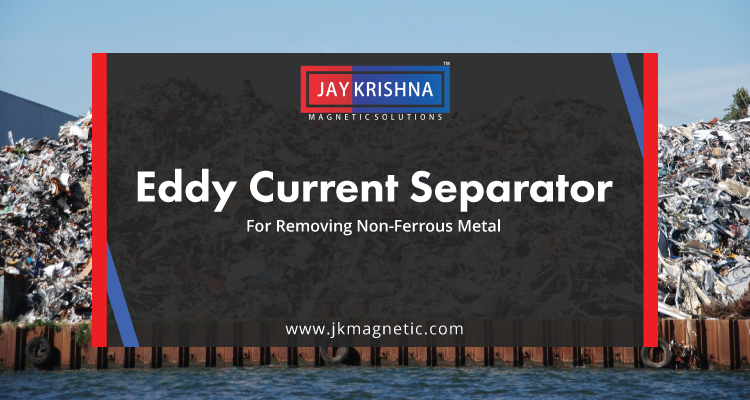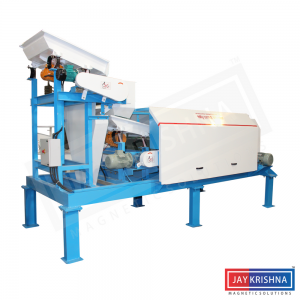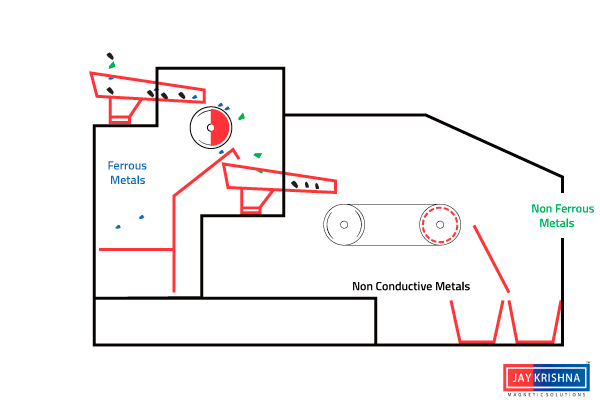Eddy Current Separator For Removing Non-Ferrous Metal

Eddy currents separators by Jaykrishna Magnetics Pvt. Ltd. are usually used to separate non-ferrous metal like aluminum, brass, copper, lead, etc. Eddy current separation is used to separate metals based on a high conductivity-to-density ratio. This technology is able to separate and recover non-ferrous metals from recycling as well as industrial waste.
How does Eddy Current Separator work?
Eddy current separators respond to the problem of separating non-ferrous metals from the waste refuse and depend on the ability of metals to conduct electrical current. If the magnetic induction in a material change with time, a voltage is generated in that material and the induced voltage produces a current called eddy current.
The Eddy Current assembly consists of a rotor which comprises of magnet blocks (generally ferrite ceramic) which are spun at over 2500 rpm (rotations per minute) to produce eddy current. This eddy current reacts with different metals based on the conductivity-to-density ratio, creating a repelling force on the charged particle. Light and a conductive metal, such as aluminum, can easily rise and thus be ejected from the normal flow of the product stream making separation possible.
Eddy current separators have been extremely crucial for the waste recycling industry because of the high value of non-ferrous materials recovered.
Eddy currents separators offer non-ferrous metal separation in three fractions of different combinations of materials:
- A composite packaging and soft aluminum fraction, a rigid aluminum fraction and a non-metallic fraction
- A ferrous metal fraction, a non-ferrous metal fraction and a nonmetallic material fraction
- An aluminum fraction, copper and lead fraction and non-metallic material fraction
Working Principle:
Size and shape
The size of the particles in the flow of material is the important factor for achieving good efficiency of separation. Eddy currents induce repulsive forces in the metal that cause it to be ejected with a certain trajectory. As a result, the non-ferrous metals have a different ejection trajectory than the other residue and inert materials in the product stream. This ultimately results in a range of trajectories for inert and non-ferrous material. For example: it is easier to separate aluminum than copper.
Size also plays an extremely important role in the eddy current separation process. For example, a round metal object has less air resistance than a wire or a bent piece of sheet metal. This also affects the range of trajectories.
Placement
In all industries, Eddy current separators are placed at the end of the production line. Prior to that, the following processing steps take place:
- shredding/crushing of the material;
- sieving of the various fractions;
- iron and ferrous separation;
- non-ferrous separation;
Eddy Current Separator Video:
Why chose Eddy Current separator from Jaykrishna Magnetics Pvt. Ltd.?
- It has a solid structure with anti-vibration pads
- The method is full proof and hence no loss of valuable material
- The maintenance is low
- The design protects recycling equipment with negligible wear and tear
- High yields of non-ferrous metals recovery
Industrial applications:
- Aluminum Scrap Recycling
- Rubber Scrap Recycling
- E-waste Recycling
- Municipal Solid Waste processing and recycling
- Glass Collect Recycling
- PET Flakes Recycling
- Plastic Waste Recycling
- PVC Scrap Recycling
- Zorba
Jaykrishna Magnetics Pvt. Ltd. is the most reputed name in magnetic separator manufacturing since last 38 years. Our magnetic separation technology is designed and manufactured using the latest technolgy to fulfill the client requirement. If you are looking for eddy current separator or any other kind of magnetic separator then feel free to contact us by clicking here. Our team will get back to you with more information.
Read More:



